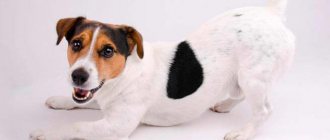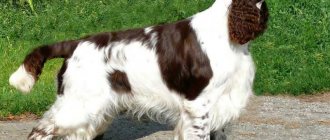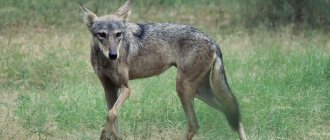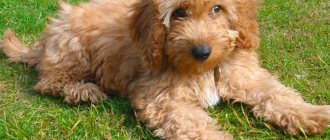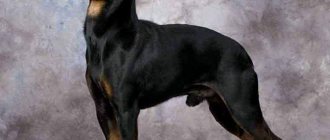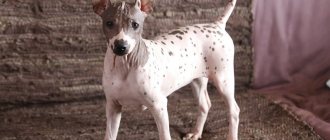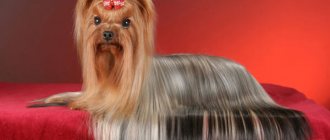Video
* We invite you to watch a video about the Bedlington Terrier . In fact, in front of you is a playlist in which you can select and watch any of 20 videos about a given dog breed by simply clicking on the button in the upper right corner of the window. In addition, the material contains quite a lot of photos. By looking at them you can find out what a Bedlington Terrier looks like.
In this article:
|
Rate the material!
[Total votes: 0 Average: 0]
How to choose a puppy
If you want to have a healthy dog, do not buy a puppy from your own hands. Find a reputable Bedlington Terrier kennel where the dogs are professionally bred and can be ensured that they are free from genetic diseases.
A healthy puppy is sociable, active, has an appetite, is inquisitive and playful, and is ready to approach people.
It is worth looking at at least one of the parents to see their temperament.
Examination of siblings and in-laws is also helpful in assessing what the puppy will be like when it grows up.
The Bedlington's coat has an unusual combination of hard and soft hairs. It tends to curl, especially on the head and muzzle. Therefore, be prepared for careful and frequent maintenance.
History of the origin of the Bedlington Terrier
There is no exact information about the appearance of this breed. It is known that its active development took place in medieval England, on the border with Scotland. However, there is no reliable information about which country Bedlington Terriers originated from. Some dog breeders believe that the dogs traveled with the gypsies, who brought them to England. 200 years ago the breed was called the Rothbury Terrier.
Dog experts believe that the roots of the breed go back to another terrier - the Dandie Dinmont. Initially, dogs were bred to hunt rodents and poultry. The gypsies incited the animals to catch and drag away ducks, chickens, and turkeys from other people's farms, past which the camp was walking. Although the appearance of dogs can be considered aristocratic, in fact they have excellent hunting instincts. Man gave this appearance to the four-legged animals.
In addition to its closest relatives, which include whippets, border terriers, and Kerry blue terriers, hounds, greyhounds, and poodles participated in the formation of the breed. In addition to hunting rodents, the ancestors of Bedlington Terriers participated in dog fighting and racing. In the 19th century, dog shows began to gain popularity. The breeders gave the dogs a more sophisticated image, and instilled a more flexible character.
However, not all admirers of the breed agreed with this decision. In the 1970s, the Working Bedlington Terrier Club was created, whose task is to preserve the breed qualities of the animals. The first National Terrier Club was organized in 1873. The breed is widespread in Europe, the USA, Australia, Africa, and Canada. In Europe and in our time there are nurseries aimed at working breeding.
Modern representatives of the breed mainly serve as pets. Bedlingtons are most popular among aristocrats, which makes them quite an expensive and rare breed. In Russia, breeding dates back to the 1950s. Due to the low popularity and low demand in our time, it is easy to maintain the purity of the breed and the working skills of the animals.
Purpose of the breed
Initially, Bedlington Terriers were bred and used as hunters of badgers, hare and other burrowing animals. There are rumors that once a pack of such dogs was able to drive and hold an adult bear until the hunters arrived. Dogs were also used to catch rats.
In the 18th-19th centuries, they even organized baiting competitions, in which Bedlingtons sometimes managed to destroy a hundred rodents in 10 minutes. This feature was often used by miners, who took such dogs with them into the mine to fight hordes of rats.
Over time, the breed gained recognition among nobles and gradually lost some of its working qualities, turning into calmer decorative dogs. And instead of hunting trophies, Bedlingtons began to bring their owners awards from exhibitions.
Bedlington Terrier - description of the breed
Dogs have an interesting, one might even say extravagant, appearance. They have a resemblance to little sheep. The creatures are graceful, slender dogs with a muscular, lithe build. The appearance is similar to hound dogs. The bones are strong, the muscles are pronounced. The body is oblong and powerful. The chest is large and deep. The back and lower back are arched. The stomach is tucked.
Bedlington Terrier parameters:
- Height - 38-42 cm;
- Weight - 8-10 kg.
The height of males is a couple of centimeters higher than that of females. Weight practically does not depend on gender. A distinctive feature of the breed is its wedge-shaped, pear-shaped head. The muzzle is elongated. The transition from the forehead to the nose is straight, without bends, like in hounds. The upper part of the head, from the nose to the crown, is covered with thick hair. The jaw is long, tapering towards the nose. The ears are medium in size. The fur on them is usually shaved, with the exception of the tassels on the tips.
The ears are shaped like a walnut leaf, drooping, and fit tightly to the cheeks. Lips are not saggy. The neck is slender, cone-shaped, without folds. The nose is large, well pigmented, black or brown, with black nostrils. The eyes are medium size, deep set. The shape resembles a triangle. The color, depending on the color, can be amber, dark or light brown.
The limbs are of medium length, with well-developed muscles. The front legs are straight, set parallel to each other. The paws are long, the toes are gathered into a ball. The pads are thick. The hind limbs are slightly longer than the forelimbs, but it seems that the hind limbs are shorter. The tail is of medium length, low set, pointed at the end. Does not rise above the line of the back.
Brief characteristics of the dog
- Other possible names: Rothbury Terrier, Rothbury Terrier, Rodbery Terrier, gypsy dog, gypsy dog.
- Adult height: according to the standard 40-41 cm, but 41 cm is also considered the norm.
- Weight: from 8 to 10 kg.
- Characteristic color: sand, light brown (liver), blue, blue and fawn.
- Coat length: medium long, thick, soft, wavy.
- Life expectancy: on average 15 years.
- Advantages of the breed: smart, clean, loyal, gets along with children, a good companion.
- Difficulties of the breed: stubborn, can be irritable and even aggressive, coat care is required.
- Average price of a Bedlington Terrier: from $500 to $1000 or more.
Popular Bedlington Terrier colors
The breed standard is limited to a mixture of coarse, dense hair and a soft undercoat. Bedlingtons are curly and sheep-like. The color of the dog depends on the undercoat. The more of it, the softer, lighter and silkier the wool. The guard hair does not fit tightly to the body, forming curls. Most of the curls are on the head. The hair curls and becomes like a cap. Its color is much lighter than the main tone.
Acceptable colors:
- Blue;
- Sand;
- Liver.
In general, white, red-brown, gray, reddish-white colors can be found. Most clubs only accept dark shades. Blue dogs have a black nose and dark brown eyes. Liver-colored individuals have brown noses and amber eyes. Sand puppies are lighter in color than adults, which are almost the same as liver puppies. There may be some markings on the fur.
Black, speckled and white individuals look very beautiful, but are prohibited by the standard. They can only be used as pets and are not allowed for breeding. Bedlington puppies are born dark, almost black. As they mature, the coat becomes significantly lighter, sometimes to white. Guessing the color of an adult is sometimes beyond the power of even experienced breeders.
The final shade is formed by approximately 2 years of age. At exhibitions, experts give preference to individuals with distinct pigmentation and rich shade. The most common color is blue. Such dogs have a black nose, eyelids, pads, and lips; in four-legged sand and liver-colored dogs, they are brown. Pigmented areas of skin resulting from damage are not considered defects.
Character and habits of Bedlington Terriers
The Bedlington Terrier has a cheerful personality with a lot of energy. These animals are not suitable for couch potatoes, who will not be able to provide them with proper exercise and long walks. These are the conditions that will help your pet feel comfortable. A high level of intelligence allows dogs not only to notice and remember everything that happens around them, but also to draw their own conclusions.
The creatures love active games and are excellent swimmers. Of all the entertainments, preference is given to ball games. Animals have a strong character and know how to defend their rights. If the owner applies punishment in the form of brute physical force, the pet may snap or growl. They place small children below themselves in the hierarchy, so they can hurt them.
If you train a dog from early childhood, it will not have the impression that it is the main one in the family. She will grow into an affectionate, devoted pet, capable of defending its owner. But still, every Bedlington is characterized by a refined egoism, which manifests itself in a love for everyone’s attention, a craving for praise and approval. Four-legged animals love to jump and are easy to train.
The animals will happily go on a hike with their owner. They will feel happiest in the forest or by the river. After that, they will happily lie with their owner for a couple of hours on the couch. Pets do not tolerate separation well, so leaving them alone for a long time is not recommended. Owners who spend all day at work should avoid buying a Bedlington Terrier and look for another breed.
They are not used as watchdogs. However, the creatures have excellent hearing and immediately react to an intruder. Terriers treat familiar dogs or pets living with them in the same apartment calmly. However, clashes between animals of the same sex cannot be ruled out. Males, having entered into a skirmish, do not retreat until they receive serious injuries. Therefore, you should keep them on a leash during walks.
Well-mannered individuals will not show aggression towards strangers who come into the house. Learning is easier to perceive in a playful form. The hunting instincts of dogs will not make it possible to keep rodents in the house. Nowadays, Bedlingtons are kept exclusively as companions. They don't like to bark loudly. They understand when they can frolic and fool around, and when they need to be quiet and calm.
Character
The Bedlington Terrier is a loyal, friendly, playful dog. She needs to be close to people, participating in everything they do.
Despite its small size, the Bedlington vigilantly guards the owner's property; if strangers appear on the doorstep, the dog will immediately notify the owner about them. Noticing danger, the terrier fearlessly rushes into battle, even if the enemy is superior in strength and size.
Bedlingtons should not be left alone with small children. The fact is that representatives of the breed do not tolerate rudeness and pranks (poking in the eyes, pulling the tail or ears...). School-age children can already be told how to behave with such a pet.
If a child treats a terrier properly, the dog will become a loyal friend and tireless playmate.
Bedlington is not very friendly to strangers. Does not show open aggression, but only if they behave peacefully. It takes time to gain a terrier's trust.
Gets along well with pets. He just doesn’t tolerate domination in his direction. Small animals, especially rodents and birds, are not recommended to be kept in the same room as Bedlingtons. A born rat catcher and small game hunter may perceive them as his prey.
Interesting facts about Bedlington Terriers
The name of the breed comes from the town of Bedlington, where the English Lord Rothbury lived. The squires who served the lord showed him dogs of this breed. He was delighted with the talents inherent in terriers. Rothbury acquired several individuals from traveling gypsies and began active breeding. There is a legend that Rothbury valued his “lambs” much more than his subjects.
Having become an ardent fan of the breed, the lord even named it first in his honor. This name existed until 1825. The first individual to receive the new name was a pet named Piper, owned by Joseph Ainslie of Bedlington. On her first hunt at the age of 8 months, she managed to defeat a badger in a fight. Even when Piper became old and toothless, she was taken on hunts to set an example for the young dogs.
The gypsies were the first to discover the breed's useful skills, so they used the dogs as pickpockets. The four-legged animals dragged poultry from farms and small domestic animals. Pets are so easy to train that they are often used in circus performances. Dogs can jump high and dig tunnels. This should be taken into account by owners living in the private sector.
The coat may change more than once throughout the life of a terrier. Being born dark, the puppies gradually lighten. Also, color can change due to stressful situations or after childbirth. Hair color is affected by the change of seasons and hormonal imbalances. Of all the delicacies, creatures prefer unsalted cheese. Animals practically do not shed. Even in spring, hair does not remain on the wearer's clothes.
Price and where to buy a puppy
It is best to buy a dog from a professional breeder or kennel. In this case, you can be sure that the baby’s pedigree contains only purebred ancestors, and the puppy himself will be given all the relevant documents. A puppy bought secondhand may be too aggressive, since neither he nor his parents most likely received professional education and training. The cost of a terrier varies from 45 to 70 thousand rubles.
Pros and cons of Bedlington Terriers
The cheerfulness and large supply of energy of four-legged animals will be an advantage for people leading an active lifestyle. However, this same quality will be a punishment for phlegmatic people who like to spend weekends at home on the couch. This dog will suit an owner with a strong character, a balanced psyche and a touch of humor. But, before you go to the nursery to buy, you should study all the pros and cons of the dog.
Advantages:
- Intelligence;
- Easily trainable;
- Devotion;
- Cleanliness;
- Suitable for apartment maintenance;
- Exotic appearance.
Bedlingtons can show their character in different ways. At home, they are cute and mischievous creatures who do not cause much trouble. On the street, “sheep” can turn into ruthless predators, ruled only by hunting instincts. All the negative qualities of creatures appear from a lack of attention from the owner. Without proper training, your pet will cause a lot of trouble.
Flaws:
- Dislike of small animals;
- Craving for digging tunnels;
- Jealousy, selfishness;
- Stubbornness, touchiness;
- Quarrels with dogs of the same sex.
Thanks to their high intelligence, four-legged animals quickly understand that it is much easier to get the owner’s attention not with a touching wag of the tail, but with all sorts of tricks. Damaged shoes and puddles in the apartment in most cases signal that the pet has been forgotten. Lack of training can provoke uncontrollable outbursts of aggression in a pet. The dog may bite family members.
Four-legged animals are unpretentious to their living conditions. A small apartment will suit them just fine. During walks, animals rarely try to escape. They watch their owner all the time and wait for him to invite them to play. If the owner is in danger, the pet will rush to his defense, regardless of the size of the enemy. At this moment, a ferocity can emerge that will not subside until the enemy's last breath.
What psychology
The breed is considered to be very alert and intelligent. First of all, a hunting dog has all the characteristics of a companion and is designed to protect its owner.
The main character traits can be identified:
- responds well to training. If you start training a dog from a young age, you will notice how quickly the puppy learns all the commands;
- The dog does not perceive the raised tone well - it immediately begins to feel guilty, which can lead to prolonged depression. Therefore, breeders do not recommend shouting or scolding your pet;
- needs constant physical activity - the history of the breed confirms this; in order for the pet to feel good, it needs to be walked often and for a long time. The dog is not suitable for homebodies;
- an energetic friend - for children, the fidget is a good pet, the dog is friendly to its little owners and will protect them.
For reference, you can view a photo of the Bedlington Terrier. By the way, the breed is very friendly with other dogs, so you don’t have to be afraid to take it to shows or take it out into the world.
Breeding Bedlington Terriers
The breed standard is very strict for Bedlingtons. Only individuals that fully meet the permitted criteria are allowed for breeding. If a puppy has abnormalities at birth, it is prohibited to breed it. To ensure that future offspring are endowed with improved breed characteristics, only male dogs that have received awards at exhibitions are allowed to breed.
The first heat in female dogs occurs at the age of 12-14 months. However, this can also happen at six months of age. This fact does not mean at all that the pet is ready to produce offspring. Readiness for pregnancy and bearing offspring occurs at approximately 2 years. The duration of estrus is 20-21 days, the frequency is 1-2 times a year. You can notice its onset by swollen genitals and frequent urination.
During this period, mating is carried out 3 times on days 11-14. Mating takes place on the territory of the male dog, but it is better to organize acquaintance in a neutral place. A sign of successful conception will be a rounding of the abdomen and a change in psychological state. The pet requires more affection, becomes more docile, calmer. A specialist can determine pregnancy by palpation at 3 weeks.
The duration of pregnancy is 55-60 days. The size of the litter is determined by the age of the bitch. The younger the female, the fewer puppies she will have. The approach of labor can be determined by measuring rectal temperature. A few days before giving birth, it drops to 37 degrees. Each puppy is born within 3 hours. The number of afterbirths must match the number of babies.
It is necessary to assemble a “maternity kit” in advance so that the birth is as comfortable as possible for both the pet and its owner. The place where the bitch will whelp should be covered with soft diapers. A bowl for placenta and a heating pad for newborns should be ready. Sterile scissors and a medical clip are useful for cutting the umbilical cord. A pen, notebook and watch are needed to mark the time of birth of babies.
Training and education
It is important to socialize your Bedlington as early as possible. It is known that the terrier's fear manifests itself in the form of aggression.
In order for such a pet to behave adequately in public places, it is necessary to accustom it to transport on busy streets, to passersby and to other people's animals.
The character of the terrier is not at all the same as that of sofa, decorative dogs. Therefore, Bedlington training should be consistent, firm, but without rudeness and physical punishment.
Rewards in the form of small pieces of dried offal and slices of unsalted cheese work well.
It is also preferable to use game tactics during lessons, without monotonous, boring drills.
It is recommended that your Bedlington Terrier take an intermediate or advanced obedience course. Many terrier owners are members of burrow dog clubs with their pets.
Interesting Facts
- Bedlington Terrier puppies are born with a brown or black coat color. As they grow older, the coat becomes lighter. The final color can be observed at two years of age.
- After childbirth, after a stressful situation and for other reasons, the color of the Bedlington's coat may change.
- The Bedlington Terrier was especially popular among the gypsies. Thanks to the intelligence and intelligence of these dogs, it was easy to teach them to steal wallets from unwary passers-by.
Caring for Bedlington Terriers
The appearance of animals is their calling card at all kinds of competitions and exhibitions. Therefore, caring for dogs requires special attention. Although the creatures practically do not shed, they need to be brushed every day. Adults are bathed every 20 days. For washing, choose a conditioner that prevents the formation of lumps. Overgrown hair between the toes should be removed.
You can cut four-legged animals yourself, only if they are not exhibition specimens. It is better to trust the trimming of such dogs to specialists. Nails should be trimmed once a month. From early childhood, children are taught to brush their teeth with a special attachment. Ear care involves removing wax and hair from inside the shell. The eyes are cleaned every day with a soft cloth soaked in warm water.
In ancient times, pets lived in barns and poorly equipped utility rooms. Now, animals pampered with comfort require completely different conditions. There should be a place in the room for the dog. A wide pillow with rubber toys next to it is suitable as a bed. For puppies in the first months of life, they will need a litter tray until they are accustomed to walking.
You need to go for walks with your Bedlington at least 2 times a day. Exercise and physical activity will not only strengthen your pet’s immunity, but will also have a positive effect on its life expectancy. Timely treatment for parasites is the key to good dog health. At the first signs of infection, including nausea, yellowing of the whites of the eyes, fever, you should consult a doctor.
Bedlington Terrier diet
Feeding Bedlington Terriers requires a special approach and some knowledge. It's all about copper toxicosis, which representatives of this breed are prone to. So, animals must be on a diet. Feeding should be done more often than 2 times a day, but in smaller portions. For adults, the daily feeding rate is 3-4 times. Food should be fresh, at room temperature.
List of products required for consumption:
- Rice;
- Lean meat;
- Dairy products;
- Sea fish without bones;
- Eggs;
- Vegetables;
- Offal.
To make the coat shine and provide the four-legged body with vitamins, add 1 spoon of sunflower oil to the food once a day. Cereals should be cooked in plain water. The broth is added to them before use. Raw vegetables are grated. As a treat, they give rabbit or turkey meat, pieces of pumpkin. Terriers love unsalted cheese and will be happy with this treat.
Prohibited products:
- Baking, sweets;
- Seasonings, marinade;
- Smoked meats;
- River fish;
- Tubular bones;
- Legumes;
- Fatty meat, liver;
- Buckwheat.
If the animal eats exclusively dry food, seaweed extract should be added to it. The gastrointestinal tract of babies is not able to digest solid food, so puppies are first fed breast milk and then fermented milk. At 2 months old dogs eat 5-6 times a day. Gradually, by the year, feeding is removed. Ready-made food should be purchased in premium and super-premium class.
Natural products should be selected with low copper content due to liver problems. Buy store-bought food, taking into account the characteristics of the breed. Your pet should have 2 bowls, one of which always contains clean, cool water. With natural feeding, the pet does not receive all the substances the body needs. Therefore, in spring and autumn, vitamin and mineral complexes are added to the diet.
Maintenance and care
In the Russian climate, Bedlington Terriers are kept in apartments and houses. At the same time, it is permissible to walk a dog in any weather - after one and a half to two hours of walking in parks and squares, the animal will not freeze. If you want to maintain a presentable appearance for your ward, buy protective overalls for the off-season period. Despite the fact that Bedlingtons are tidy by birth, even they are not immune from dirty splashes flying from under car wheels. However, moderation must be observed here too. Prolonged wearing of waterproof clothes is fraught with the formation of woolen tangles on the dog’s body, which do not decorate it at all.
Hygiene and grooming
Bedlington Terriers have abundant hair not only on the body, but also in the ear funnel. In this regard, once a week the ear canal must be cleaned of secretions, simultaneously plucking out hairs that interfere with natural ventilation and accumulate sulfur secretions. The most convenient way to remove hair from the ear is plucking by hand or with tweezers. If the dog reacts too strongly to “epilation”, it is permissible to use scissors with rounded edges.
Once a month, the Bedlington Terrier should trim its nails with a clipper or any other nail clipper. If this is not done, the claw plate will bend inward, interfering with walking and distorting the position of the legs, which is especially harmful for show pets. For owners walking with animals on roads sprinkled with reagents, it is wiser to put their pets in special waterproof socks. Otherwise, after each such exit, the Bedlington will have to heal the cracked skin of the pads. As an alternative to walking socks, it is allowed to use protective waxes and balms for paws such as “Let's go for a walk!”, “Vedinol”. These products prevent the absorption of chemical compounds into the skin, protecting it from peeling and cracking.
The breed's teeth are healthy, so to prevent plaque and tartar, it is enough to give your pet a hard treat like dried beef ears, cartilage or dry fortified croquettes. Good results are obtained by lubricating the teeth with fresh tomato juice and brushing with zoopaste, but the dog is accustomed to such procedures from puppyhood.
Bedlington Terriers do not shed seasonally. The hair is gradually renewed throughout the year, so the main care for your pet is periodic combing of the body with a rubber mitten or brush to avoid the formation of tangles. Puppies under one year of age need to be brushed more often, as they shed more intensely. Junior wool changes to adult hair, and therefore falls off faster. In addition, starting from the age of three months, Bedlington Terriers are cut. If you do not plan to trust this procedure to a groomer, get hairdressing scissors, a clipper and a slicker brush. The last tool is useful for combing the dog's luscious hair before processing it with a clipper and scissors.
Most breeders prefer the classic version of the Bedlington haircut with smooth transitions and a fluffy cap on the head. However, there is also an American technique, when the dog is cut as short as possible, and the hair on the lower part of the tail, cheeks and throat is shaved. Bedlingtons cut this way look very unusual due to the translucent skin and narrow “cap” on the skull. As for patterns of dog “hairstyles,” they are easy to find on breed forums. However, you will have to use the templates at least four times a year - if you cut your animal less often, there is a risk of getting a hopelessly overgrown pet in unkempt tangles.
Bedlington Terriers need to be bathed every 2-3 weeks. In addition, after each walk you will have to wipe the animal’s paws and lower abdomen. To make the coat look shiny and comb better, it is necessary to use conditioners along with shampoo. More frequent bathing is carried out when the goal is to grow the coat faster - the use of softening masks and balms, as well as regular brushing, make the hair more pliable and stimulate blood circulation. It is also useful to buy talc or baby powder. Over time, the strands near the dog's mouth, under the eyes, tail and on the stomach acquire a brownish tint, which can be easily neutralized if the hair is treated with talc powder.
Important: throughout life, especially during pregnancy and nursing, the Bedlington Terrier’s coat changes color intensity, becoming darker and lighter. This is a normal and passing phenomenon that does not need to be dealt with.
Feeding
The natural menu of the Bedlington Terrier includes any lean meat, frozen fish fillets, low-fat fermented milk products, fruits and vegetables and cereals (rice). Vitamin complexes and dietary supplements, which are best selected on the recommendation of a veterinarian, will help make the diet optimally balanced. Breeders often recommend high-quality industrial feeds, starting from super-premium class and higher. True, to find your ideal one, you will have to spend some time.
An important nuance: many mineral components included in ready-made food color the coat of Bedlington Terriers, but it is unrealistic to predict in advance how the dog’s body will react to a particular brand.
It is unacceptable to feed your pet scraps from your own table. In addition, sweets, smoked foods, legumes and cabbage, raw carrots, nuts, chocolate, buckwheat, sweet fruits, as well as offal (liver, kidneys) are contraindicated for the breed. Tubular bones are also not given to Bedlingtons, nor are leafy greens.
Diseases and health problems
To avoid serious diseases, animals are vaccinated against the following diseases:
- Plague;
- Rabies;
- Infectious hepatitis;
- Parainfluenza;
- Parvovirus enteritis.
The first vaccination is carried out at 2 weeks of age. After the injection, your pet should not be bathed, fed abundantly, or taken outside. Immunity develops within 12 days. During this period, it is better to refrain from communicating with other animals. After the first vaccination, the baby may experience fever, nausea, diarrhea, and weakness. At this time, it is necessary to ensure the puppy's comfort.
Subsequent vaccinations are given at 3, 6 months and a year. Then, vaccinations with a complex vaccine are performed annually. Despite their good health, the creatures have a predisposition to certain genetic diseases. Copper toxicosis manifests itself as nausea, diarrhea, and lack of appetite. A DNA test allows you to determine an individual's predisposition to this disease.
Junk food can lead to liver pathologies. Fatty, spicy, salty foods can provoke gastrointestinal disorders and negatively affect the life expectancy of the animal. Thirst and increased urine output can signal problems with the kidneys - hypoplasia. Dogs can suffer from a congenital or acquired illness - a dislocated kneecap. Manifested by lameness, surgical intervention is possible.
A rare but still common disease is epilepsy. Congenital anomalies include retinal dysplasia. The disease does not lead to total blindness, but individuals with this disease are not allowed for breeding. The disease can be detected at 7-12 weeks of age. Other eye problems include glaucoma, conjunctivitis, abnormal eyelash growth, and entropion.
Advantages and disadvantages
Cheerful and cheerful, Bedlington Terriers require early socialization and a lot of patience on the part of their owners. In early adolescence, their independence and willfulness are quite clearly manifested, which go away a little with growing up and with proper upbringing.
They are loyal to their owners and can easily cope with the role of a companion. Such dogs will give children all their love and tenderness and will become a real living toy for them.
Pets and other dogs are treated calmly and discreetly. True, sometimes hunters still appear in them, especially for cats, hamsters and other small domestic animals.
Despite their apparent good nature, Bedlingtons often tend to show aggression and irritability. These qualities can be eradicated by giving the dog love and care.
